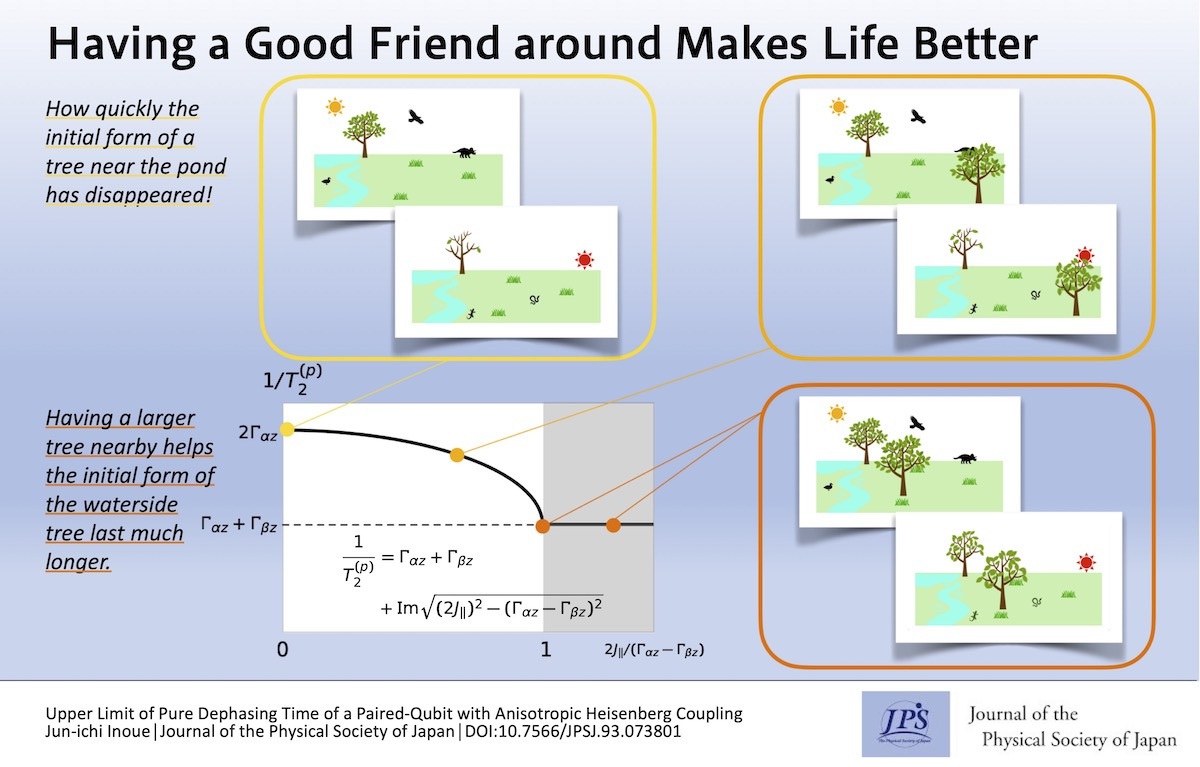Having a Good Friend around Makes Life Better
© The Physical Society of Japan
This article is on
J. Phys. Soc. Jpn.
93,
073801
(2024)
.

We are almost ready to roll out the application of qubits, which are two-state quantum-mechanical systems. Quantum computers are likely to be at the forefront, but sensors using quantum technology represent other platforms that are worthy of consideration. In this case, the best bet for qubits is to use point defects in diamonds, which are called negatively charged nitrogen-vacancy (NV-minus) centers. The qubit situated in the center is ideal in that it operates stably even at room temperature. This property is in stark contrast to that observed in superconductors.
Any quantum state is susceptible to a variety of noise sources, which ultimately result in the decay of the quantum state over time. A comprehensive study has demonstrated that the use of qubits with slow decay rates facilitates the attainment of a more refined sensing resolution. Therefore, one of the most important things to consider in a sensor is how long the quantum states can be maintained. Hence, a slow decay rate is a big plus.
As is easily expected, a short distance between a quantum sensor and a target to be measured is good for sensing. Therefore, having the sensor right next to the diamond surface would be advantageous. However, it's not that simple because surfaces have many of surface-specific sources that can accelerate the decay.
To address this trade-off, this article demonstrates that coupling with another qubit that has a slow decay rate improves the decay rate of a qubit near the diamond surface. For the case that anisotropic Heisenberg coupling between a qubit pair is assumed, the analytical result for the decay rate as a function of the coupling strength has been derived. The formula demonstrates which component of the interaction is the most dominant, and reveals that there is a limit to the potential for improvement in the decay rate.
This finding could be useful in quantum sensing technology, especially cases involving NV-minus centers in diamonds.
(Written by J.-i. Inoue.)
J. Phys. Soc. Jpn.
93,
073801
(2024)
.
Share this topic
Fields
Related Articles
-
Qualitative Changes in Kinetic Pathways Driven by Hydrodynamic Interactions in Dense Colloidal Suspensions
Cross-disciplinary physics and related areas of science and technology
Statistical physics and thermodynamics
Structure and mechanical and thermal properties in condensed matter
2025-4-18
Even in dense colloidal suspensions, where long-range hydrodynamic interactions are screened, near-field hydrodynamic interactions qualitatively influence the selection of kinetic pathways.
-
Exploring the Vibrant Interplay of Machine Learning and Physics
Cross-disciplinary physics and related areas of science and technology
Electron states in condensed matter
Elementary particles, fields, and strings
Mathematical methods, classical and quantum physics, relativity, gravitation, numerical simulation, computational modeling
Statistical physics and thermodynamics
Superconductivity
2025-3-13
This Journal of the Physical Society of Japan Special Topics edition explores how physics and machine learning complement each other and can solve unresolved problems in physics.
-
Exploring Materials without Data Exposure: A Bayesian Optimizer using Secure Computation
Cross-disciplinary physics and related areas of science and technology
Measurement, instrumentation, and techniques
2025-2-6
Secure computation allows the manipulation of material data without exposing them, thereby offering an alternative to traditional open/closed data management. We recently reported the development of an application that performs Bayesian optimization using secure computation.
-
Triangular Lattice Magnet GdGa2: Spin Cycloids and Skyrmions
Cross-disciplinary physics and related areas of science and technology
Electronic transport in condensed matter
Magnetic properties in condensed matter
2025-2-3
Careful measurements were conducted on the hexagonal magnet GdGa2 to reveal the experimental signatures of ultrasmall spin cycloids and of a potential Néel-type skyrmion lattice phase induced by a magnetic field.
-
Unlocking Secrets of Novel Charge-Orbital States in Transition-Metal Compounds
Cross-disciplinary physics and related areas of science and technology
Electron states in condensed matter
Electronic structure and electrical properties of surfaces and nanostructures
Magnetic properties in condensed matter
Structure and mechanical and thermal properties in condensed matter
2025-1-6
A new Special Topics edition of the Journal of the Physical Society of Japan features articles exploring special transition-metal compounds that exhibit novel charge-orbital states.




